Mammoths, Gems, and Gold: The Art of Sumner Silverman
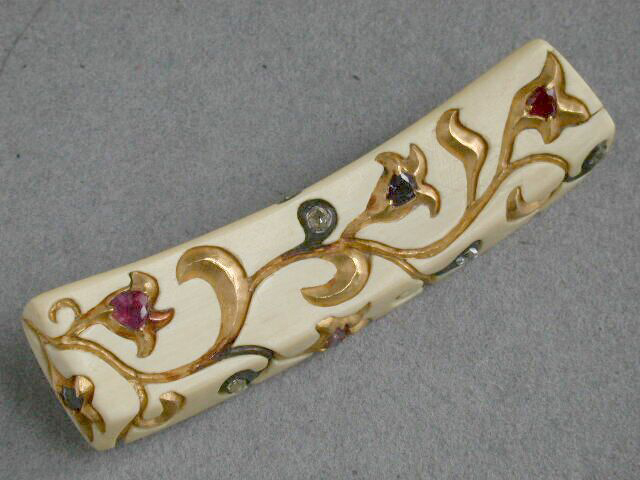 Beneath a wall of carved masks--whose smiles and grimaces suggest the presence of spirits from another culture--a bearded man in a chair is listening intently to the conversation around him. Quietly, without missing a beat, he reaches into the soft folded pouch he has by his side, and like a magician, extracts a tiny, colorful drawstring bag. From this he slips what looks like a miniature mosque or chess piece of warm ivory, studded with sapphire and ruby. It glows and sparkles in the circle of light thrown by a nearby lamp. He holds this faceted, cylindrical object in his palm, surveying it like a beloved landscape, running his fingers along its surface, fondling its contours. His hands are powerful sculptor's hands, their energy focused and concentrated in this small space; they cherish as they analyze. He turns the object, seeking what its textures and forms are telling him about the next phase of their journey from gem, metal and ancient tusk to art. Set out on the arm of his chair is a small array of tools--like a dentist's or an etcher's--and he chooses one. With scarcely perceptible motion, he begins to work the gleam of gold into one end of the form. All the while, he is listening. Suddenly, he makes an astute and funny remark that jolts the discussion to a new level, pointing out some pattern, making some connection, surprising and intriguing the group. And all the while, his hands are never still, fashioning a world.
Beneath a wall of carved masks--whose smiles and grimaces suggest the presence of spirits from another culture--a bearded man in a chair is listening intently to the conversation around him. Quietly, without missing a beat, he reaches into the soft folded pouch he has by his side, and like a magician, extracts a tiny, colorful drawstring bag. From this he slips what looks like a miniature mosque or chess piece of warm ivory, studded with sapphire and ruby. It glows and sparkles in the circle of light thrown by a nearby lamp. He holds this faceted, cylindrical object in his palm, surveying it like a beloved landscape, running his fingers along its surface, fondling its contours. His hands are powerful sculptor's hands, their energy focused and concentrated in this small space; they cherish as they analyze. He turns the object, seeking what its textures and forms are telling him about the next phase of their journey from gem, metal and ancient tusk to art. Set out on the arm of his chair is a small array of tools--like a dentist's or an etcher's--and he chooses one. With scarcely perceptible motion, he begins to work the gleam of gold into one end of the form. All the while, he is listening. Suddenly, he makes an astute and funny remark that jolts the discussion to a new level, pointing out some pattern, making some connection, surprising and intriguing the group. And all the while, his hands are never still, fashioning a world.
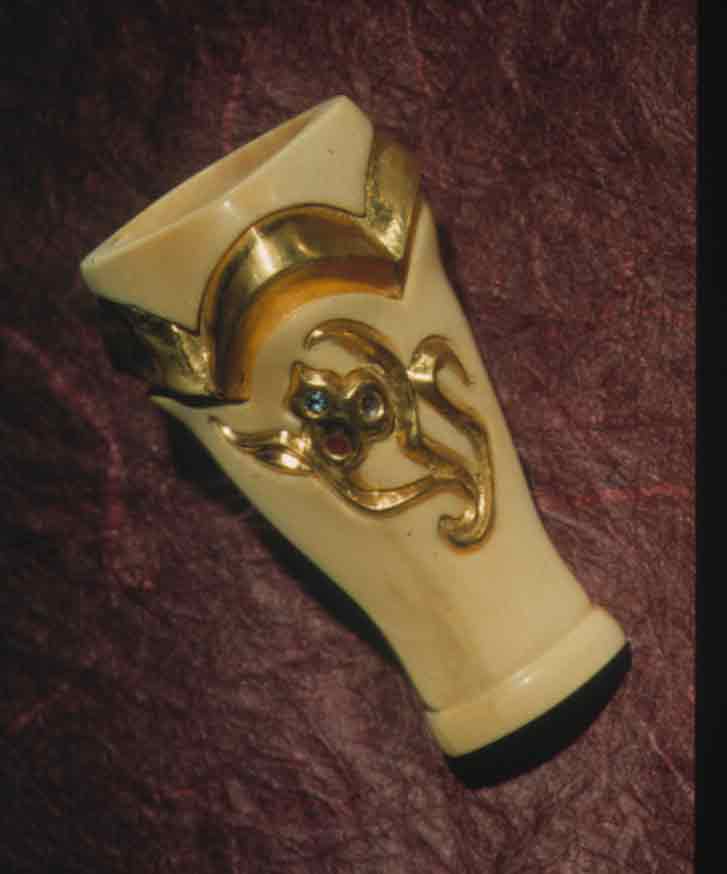 Meet Sumner Silverman, master jeweler and psychologist. The precious object he is finishing is a cigar-holder, its design inspired by Islamic architecture. With a 24-karat gold band set into a ridge around the inside of the cigar end, it is a technical tour-de-force and a sensual delight, formed from a single piece of polished mastodon or woolly mammoth tusk that is anywhere from 15,000 to 50,000 years old. Such fossil ivory, preserved in the permafrost of Alaska, Canada, or Siberia, allows contemporary artists to continue the intricate and ancient art of "bone-carving." Although the cigar-holder appears to be made of separate interlocking forms, this is an illusion created by astonishingly precise and subtle undercutting. This is a single piece that only seems, on the surface, to be two. It is a fitting metaphor for Silverman's expertise in the realms of jewelry and psychotherapy. In both disciplines, he expresses the same constellation of gifts: remarkable attentiveness, patience, a passion for history, and a brilliant grasp of design. He is fascinated by human beings: our gifts and foibles, our relentless striving to bring something into being. As an artist, he is inspired by ancient traditions to create new images and the techniques to achieve them; as a psychologist, he guides others as they explore their personal histories and arrive at new insights. He especially enjoys working with other artists and helping them find ways to flourish in a society that often relegates their profession to the margins. In our era of quick fixes--in art as well as life--Silverman follows another path, one that links him with the master artisans of the past. He understands the human scale, the way the creation of a work of art and the getting of wisdom can never be rushed.
Meet Sumner Silverman, master jeweler and psychologist. The precious object he is finishing is a cigar-holder, its design inspired by Islamic architecture. With a 24-karat gold band set into a ridge around the inside of the cigar end, it is a technical tour-de-force and a sensual delight, formed from a single piece of polished mastodon or woolly mammoth tusk that is anywhere from 15,000 to 50,000 years old. Such fossil ivory, preserved in the permafrost of Alaska, Canada, or Siberia, allows contemporary artists to continue the intricate and ancient art of "bone-carving." Although the cigar-holder appears to be made of separate interlocking forms, this is an illusion created by astonishingly precise and subtle undercutting. This is a single piece that only seems, on the surface, to be two. It is a fitting metaphor for Silverman's expertise in the realms of jewelry and psychotherapy. In both disciplines, he expresses the same constellation of gifts: remarkable attentiveness, patience, a passion for history, and a brilliant grasp of design. He is fascinated by human beings: our gifts and foibles, our relentless striving to bring something into being. As an artist, he is inspired by ancient traditions to create new images and the techniques to achieve them; as a psychologist, he guides others as they explore their personal histories and arrive at new insights. He especially enjoys working with other artists and helping them find ways to flourish in a society that often relegates their profession to the margins. In our era of quick fixes--in art as well as life--Silverman follows another path, one that links him with the master artisans of the past. He understands the human scale, the way the creation of a work of art and the getting of wisdom can never be rushed.
 When the original owner of that mammoth tusk was roaming across a frozen tundra, Stone Age artists were carving small ivory animals, like those found in the Vogelherd caves: horses and bison twisting and turning, full of life. As a designer and sculptor, Silverman can trace his artistic lineage far back to the Paleolithic, to the makers of ritual objects imbued with the energy and power of the natural world. In describing his own method of working, he senses a kinship with these forbears: "I design work while I walk or swim. I must keep my hands busy. I carry a small pouch of tools with me and will burnish, sand, or carve...This, I am sure, is how the ancients worked." And like the itinerant hunters of the past, Silverman travels widely in Europe and the East, seeking out new materials and textures to incorporate into his jewelry and sculpture, ranging from centuries-old walrus tusk to briarwood and rare gemstones like reddish-purple sugulite. By working with fossil ivory, he is literally shaping the past, giving it new life in the present. And when you hold one of these pieces in your hand, you can feel the thrill of connecting with something of enormous age, something that was once part of a living being and has now been transformed and adorned with gems.
When the original owner of that mammoth tusk was roaming across a frozen tundra, Stone Age artists were carving small ivory animals, like those found in the Vogelherd caves: horses and bison twisting and turning, full of life. As a designer and sculptor, Silverman can trace his artistic lineage far back to the Paleolithic, to the makers of ritual objects imbued with the energy and power of the natural world. In describing his own method of working, he senses a kinship with these forbears: "I design work while I walk or swim. I must keep my hands busy. I carry a small pouch of tools with me and will burnish, sand, or carve...This, I am sure, is how the ancients worked." And like the itinerant hunters of the past, Silverman travels widely in Europe and the East, seeking out new materials and textures to incorporate into his jewelry and sculpture, ranging from centuries-old walrus tusk to briarwood and rare gemstones like reddish-purple sugulite. By working with fossil ivory, he is literally shaping the past, giving it new life in the present. And when you hold one of these pieces in your hand, you can feel the thrill of connecting with something of enormous age, something that was once part of a living being and has now been transformed and adorned with gems.
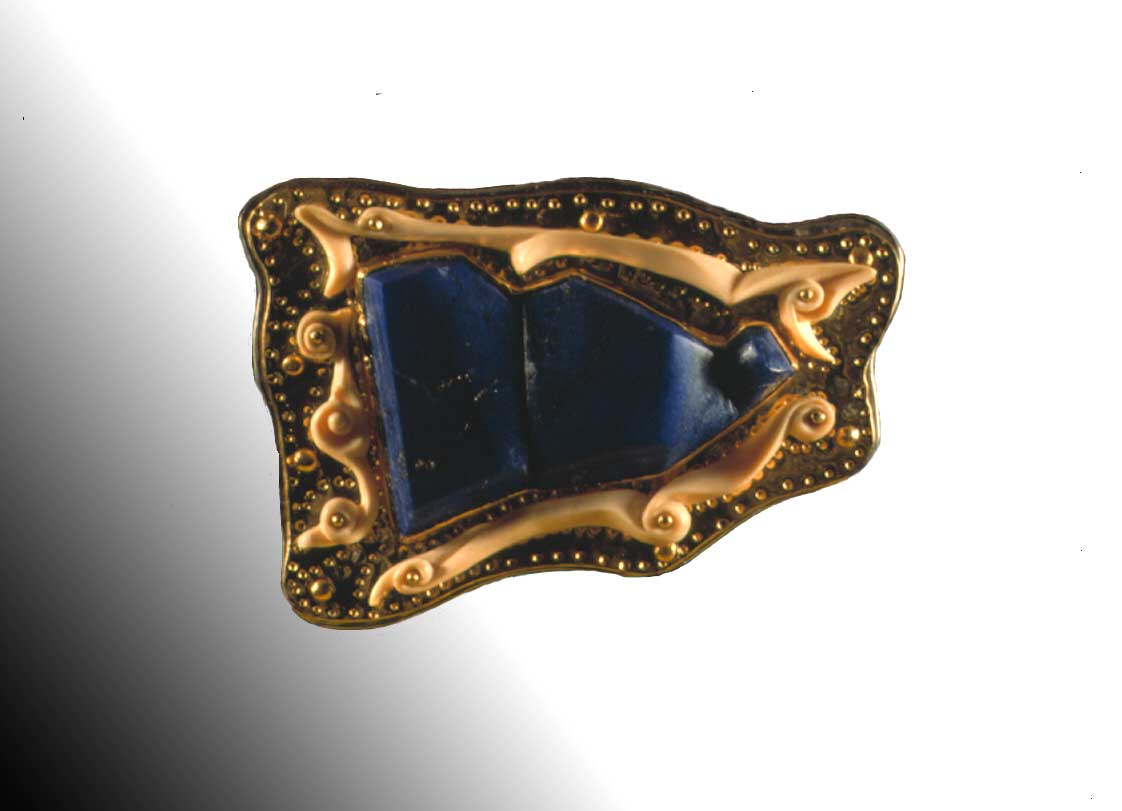 By combining organic materials with gemstones in his designs, Silverman is practicing a poetic art of compression, enriching one material by juxtaposing it with another, creating microcosms that can fit in the hand, or be worn on the body. The smooth, melted caramel of walrus tusk, two-toned from its journey through time, will be inlaid with the ageless, solar brilliance of gold. The hand and eye travel over these textures, luxuriating in their proximity. Whether he is creating cigar holders--one of the few contemporary objects used in a ritual way--or rings, brooches, earrings or small sculptures to be held and savored, Silverman is an innovator enamored of ancient legacies, someone with an ear to the ground that connects us all. He is also a man who delights in the senses, who finds textures and forms luxurious, whether they are metals and gems, or fabrics and foods. He is compelled to shape what he finds, to coax design from potential.
By combining organic materials with gemstones in his designs, Silverman is practicing a poetic art of compression, enriching one material by juxtaposing it with another, creating microcosms that can fit in the hand, or be worn on the body. The smooth, melted caramel of walrus tusk, two-toned from its journey through time, will be inlaid with the ageless, solar brilliance of gold. The hand and eye travel over these textures, luxuriating in their proximity. Whether he is creating cigar holders--one of the few contemporary objects used in a ritual way--or rings, brooches, earrings or small sculptures to be held and savored, Silverman is an innovator enamored of ancient legacies, someone with an ear to the ground that connects us all. He is also a man who delights in the senses, who finds textures and forms luxurious, whether they are metals and gems, or fabrics and foods. He is compelled to shape what he finds, to coax design from potential.
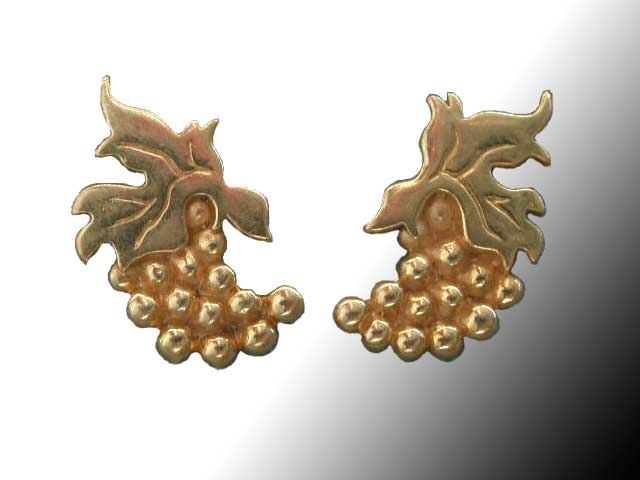 It is mid-summer on Martha's Vineyard and goldfinches loop the sky with their inquisitive "per-chicory" notes, their flash of citron a shocking brilliance lined with ebony. Bees jiggle a round universe of lavender-colored thyme blossoms on the patio. Sumner Silverman is out tending his gardens where each season he manages to coax an Eden of vegetables from the earth--gray shallots, spicy globe basil, asparagus, squash, fennel, currants, potatoes, eggplant, garlic, onions. It is almost impossible to believe what he produces each year from this small patch of land: so many forms, textures and flavors coexisting and flourishing. The curlicues of tendrils and scalloped leaves are sometimes echoed in his distinctive, curvilinear designs that churn slowly through the gold he loves to shape. The berries and currants are like the rubies he insets in metals and ivories. An early harvest of long-stemmed onions is arrayed on the porch, like a form of botanical notation gathered to make a wordless paragraph. Soon Silverman will begin to clip the ends of the shallots tumbled nearby, brushing their coats and sorting them by size. The task seems immense. But sitting in the shade, he works methodically with scissors and brush as chickadees do acrobatics in the sugar maple overhead. The trimmed shallots pile up. He turns each one in his hands, admiring its shape, feeling its form. Watching him at work, you begin to understand how all parts of his life are one: the jewelry making, the therapy, the travel, the gardening. And how the art itself grows like a living thing in rich mulch.
It is mid-summer on Martha's Vineyard and goldfinches loop the sky with their inquisitive "per-chicory" notes, their flash of citron a shocking brilliance lined with ebony. Bees jiggle a round universe of lavender-colored thyme blossoms on the patio. Sumner Silverman is out tending his gardens where each season he manages to coax an Eden of vegetables from the earth--gray shallots, spicy globe basil, asparagus, squash, fennel, currants, potatoes, eggplant, garlic, onions. It is almost impossible to believe what he produces each year from this small patch of land: so many forms, textures and flavors coexisting and flourishing. The curlicues of tendrils and scalloped leaves are sometimes echoed in his distinctive, curvilinear designs that churn slowly through the gold he loves to shape. The berries and currants are like the rubies he insets in metals and ivories. An early harvest of long-stemmed onions is arrayed on the porch, like a form of botanical notation gathered to make a wordless paragraph. Soon Silverman will begin to clip the ends of the shallots tumbled nearby, brushing their coats and sorting them by size. The task seems immense. But sitting in the shade, he works methodically with scissors and brush as chickadees do acrobatics in the sugar maple overhead. The trimmed shallots pile up. He turns each one in his hands, admiring its shape, feeling its form. Watching him at work, you begin to understand how all parts of his life are one: the jewelry making, the therapy, the travel, the gardening. And how the art itself grows like a living thing in rich mulch.
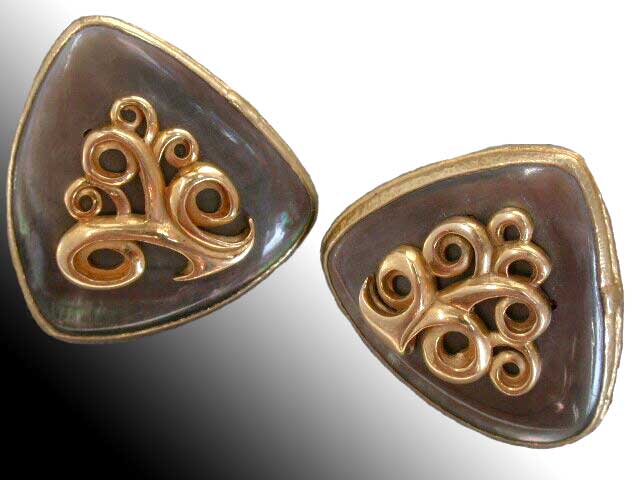 The rhythms of art are like the rhythms of the garden: there are times of preparation, and times of harvest, when everything seems to burgeon at once. Silverman's new work glitters like the sun. Now he is smitten with gold, and with the technique of repoussé, pushing out a design from behind to create a raised pattern: "Every civilization has come to the use of very thin gold sheet done in repoussé. I can't think of a culture with access to gold that doesn't have this, whether it's sewn onto clothing, or part of funerary objects." The malleability and ductility of sheets of gold hold enormous appeal for him, as does their fragility. That paradox--of fragility and endurance--is part of the ageless charm of delicate jewelry that has somehow managed to survive from ancient times and of new art that will survive into the future. He opens one of the little Nepalese drawstring bags he has piled on the kitchen table and extracts a symmetrical golden brooch based on an Afghani design. Because it is gold all over, it seems wonderfully indulgent, provoking a primordial response to this universally worshipped metal: the same little gasp of the soul elicited by the mask of Agamemnon from Mycenae, or the treasures of Sutton Hoo. The gleam that turns in upon itself as a ring or serves as an accent in Silverman's earlier work has now escaped its bounds, as if poured over the entire shape like a renegade solar flare. This produces the visceral feeling that there must be... chocolate inside the brooch, waiting to be unwrapped. Suddenly, the whole piece seems edible, delicious. Silverman is amused and pleased. He says "I think any good jewelry should have that sense that you want to pick it up and eat it."
The rhythms of art are like the rhythms of the garden: there are times of preparation, and times of harvest, when everything seems to burgeon at once. Silverman's new work glitters like the sun. Now he is smitten with gold, and with the technique of repoussé, pushing out a design from behind to create a raised pattern: "Every civilization has come to the use of very thin gold sheet done in repoussé. I can't think of a culture with access to gold that doesn't have this, whether it's sewn onto clothing, or part of funerary objects." The malleability and ductility of sheets of gold hold enormous appeal for him, as does their fragility. That paradox--of fragility and endurance--is part of the ageless charm of delicate jewelry that has somehow managed to survive from ancient times and of new art that will survive into the future. He opens one of the little Nepalese drawstring bags he has piled on the kitchen table and extracts a symmetrical golden brooch based on an Afghani design. Because it is gold all over, it seems wonderfully indulgent, provoking a primordial response to this universally worshipped metal: the same little gasp of the soul elicited by the mask of Agamemnon from Mycenae, or the treasures of Sutton Hoo. The gleam that turns in upon itself as a ring or serves as an accent in Silverman's earlier work has now escaped its bounds, as if poured over the entire shape like a renegade solar flare. This produces the visceral feeling that there must be... chocolate inside the brooch, waiting to be unwrapped. Suddenly, the whole piece seems edible, delicious. Silverman is amused and pleased. He says "I think any good jewelry should have that sense that you want to pick it up and eat it."
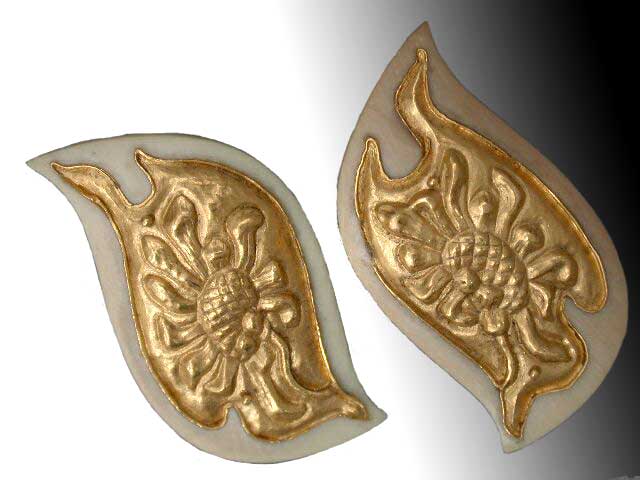 A pair of earrings in this new series is a confection of mastodon tusk--carved into an astonishing maze of delicate, lacy curves--surrounded by a thin wavy black line. There are rubies, like miniature currants, topped with tiny balls of gold. These layers--red, white, black, gold-- remind one of a sumptuous tart. There are subtle differences between the two earrings, making them seem balanced and alive: an extra seed pearl or ruby, another oval added to the cluster of ivory. Gold peeps through, like a protagonist waiting to take center stage again.
A pair of earrings in this new series is a confection of mastodon tusk--carved into an astonishing maze of delicate, lacy curves--surrounded by a thin wavy black line. There are rubies, like miniature currants, topped with tiny balls of gold. These layers--red, white, black, gold-- remind one of a sumptuous tart. There are subtle differences between the two earrings, making them seem balanced and alive: an extra seed pearl or ruby, another oval added to the cluster of ivory. Gold peeps through, like a protagonist waiting to take center stage again.
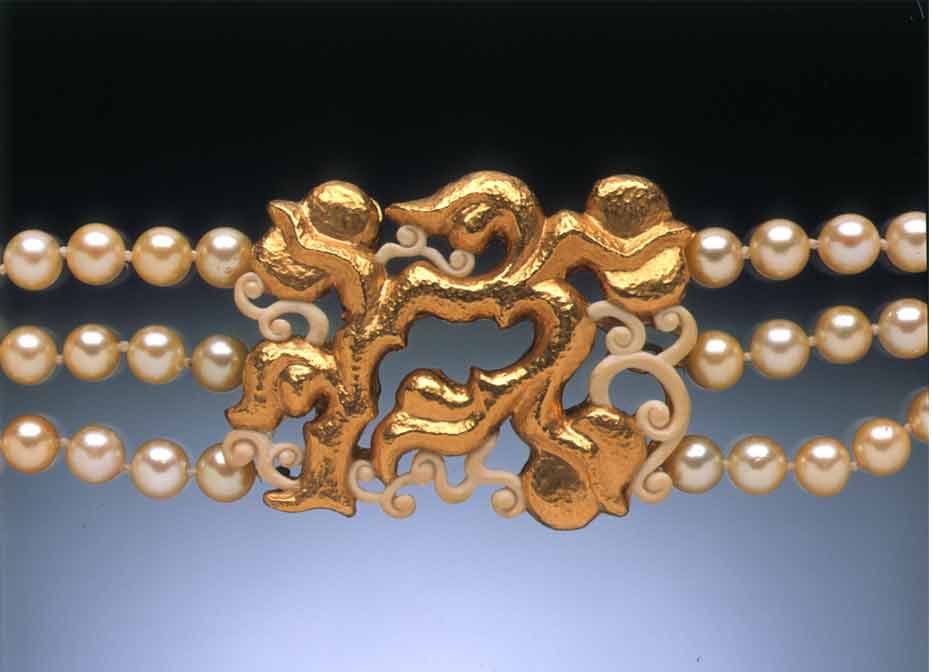 More pieces emerge like treasures from their soft hiding places: a large gold brooch inspired by Mexican designs, then a necklace with a large central piece inspired by a Scythian horse harness. The Scythians, nomadic tribes from Central Asia, who roamed north of the Black Sea from the 7th to the 6th centuries BC., were masters of animal art, casting and working solid gold pieces that ornamented clothing and shields. They created images full of muscular tension, sculpting animals, like the sacred stag, on the verge of motion. Silverman is drawn to their strong stylization and astonishing craftsmanship. The meldings of culture and forms are becoming bolder and more declarative in his new work. The scale is changing too, as single objects are linked together to create big, colorful necklaces. One combines Islamic cylindrical shapes and classical Greek medallions with African-style wrapped wires and glass beads, all strung dramatically on a leather cord. Tiny cylinders of gold are puckered at each end, almost like cloth, each element always showing the hand of the maker. Another necklace fantasia features a green garnet called tsavorite set atop interlocking shapes--a diamond set into a rectangle--formed from pieces of gold sheet like little geometric cakes, with African glass beads called white hearts, matte and shiny gold surfaces, and ivory carved into filigree patterns. This is truly an art of fusion: materials and forms brought together from so many cultures and eras to create a distinctive new style. Here the syncretism of the ancient world--where trade linked more places than we can imagine today--meets the postmodern luxury of picking and choosing from the cultural riches of all of human history
More pieces emerge like treasures from their soft hiding places: a large gold brooch inspired by Mexican designs, then a necklace with a large central piece inspired by a Scythian horse harness. The Scythians, nomadic tribes from Central Asia, who roamed north of the Black Sea from the 7th to the 6th centuries BC., were masters of animal art, casting and working solid gold pieces that ornamented clothing and shields. They created images full of muscular tension, sculpting animals, like the sacred stag, on the verge of motion. Silverman is drawn to their strong stylization and astonishing craftsmanship. The meldings of culture and forms are becoming bolder and more declarative in his new work. The scale is changing too, as single objects are linked together to create big, colorful necklaces. One combines Islamic cylindrical shapes and classical Greek medallions with African-style wrapped wires and glass beads, all strung dramatically on a leather cord. Tiny cylinders of gold are puckered at each end, almost like cloth, each element always showing the hand of the maker. Another necklace fantasia features a green garnet called tsavorite set atop interlocking shapes--a diamond set into a rectangle--formed from pieces of gold sheet like little geometric cakes, with African glass beads called white hearts, matte and shiny gold surfaces, and ivory carved into filigree patterns. This is truly an art of fusion: materials and forms brought together from so many cultures and eras to create a distinctive new style. Here the syncretism of the ancient world--where trade linked more places than we can imagine today--meets the postmodern luxury of picking and choosing from the cultural riches of all of human history
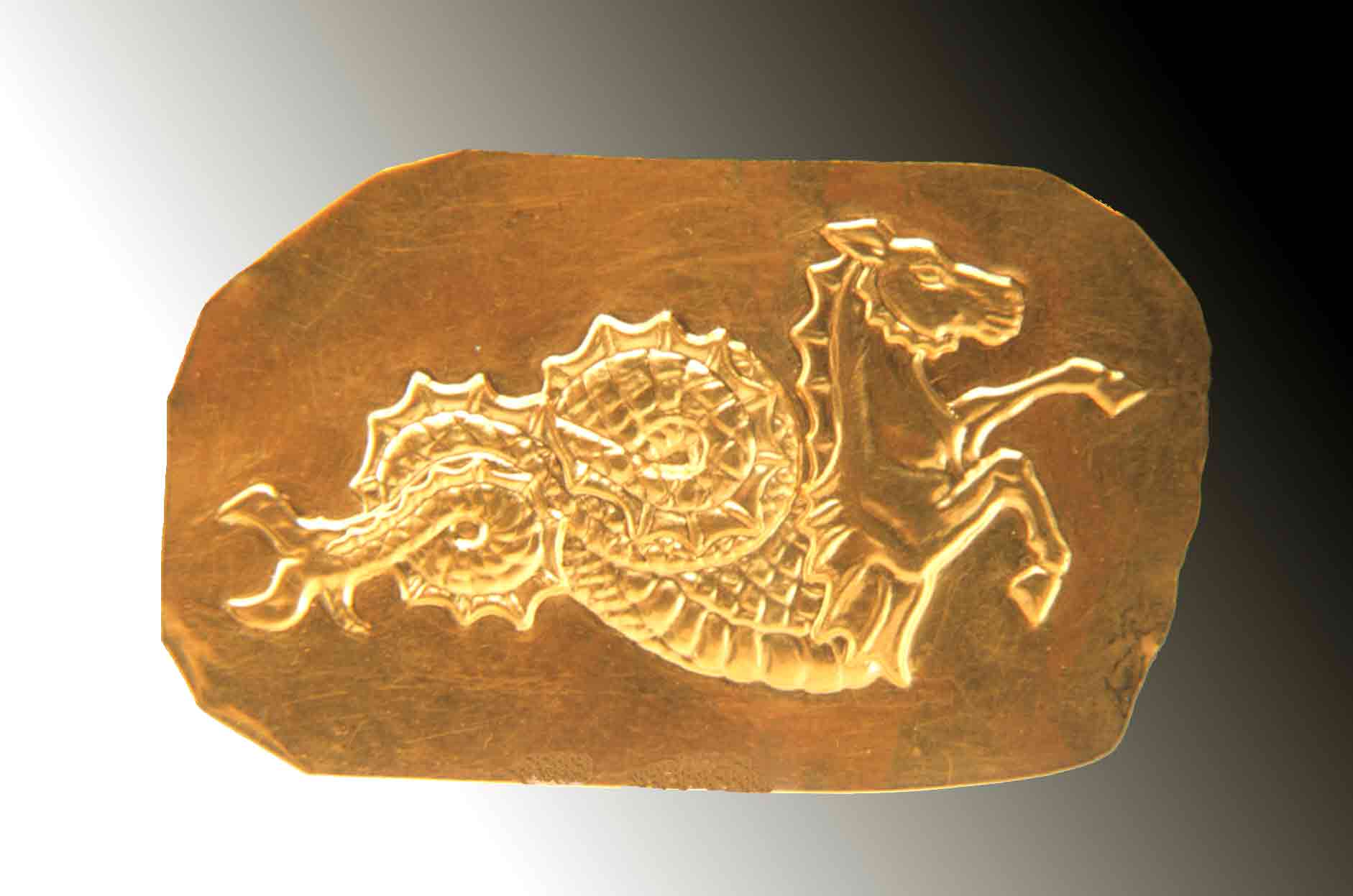 Silverman now talks about the allure of making art that is purely design-driven, that does not have to be worn and in some way conform itself to the body. Perhaps in the future he will simply frame some of his pieces, allowing them to exist purely as sculpture. In the last few months, he has been driving toward this concept in a dazzling new series he calls Fantastic Beasts of the Golden Horde, where he takes the art of repoussé to a new level with images of animals, often in motion or turmoil. In contrast with the animal combat scenes found in Mesopotamian art, here we find single creatures wearing the skin-tight gleam of gold on their flanks, kicking up their legs, pushing against the confines of their rectangular lozenge-like space. They exude an enormous sense of energy contained and only momentarily stilled, reified, but seething with impulse. One piece featuring the extravagantly antlered stag of Scythian art plays with the idea of verso and recto, showing us how the creature--itself a symbol of transformation--became increasingly stylized in the Byzantine era. The two sides of this golden rectangle are both meant to be visible; one is not privileged over the other. Another rectangular piece features a wild horse inspired by a northern Chinese griffon, its legs flying over its back in a stylization of exuberant motion. In order to make a matte gold surface contrasting with a shiny one, Silverman devised a new tool, something he often does to achieve a particular effect. Then there is a wolf with its tail wrapped around its nose; a goat-stag hybrid, twisting in its golden oval, pushing off from its edges; and a demonic cat with flailing paws, each tiny pad and claw overlapping. Like stills from a molten Aesop's fables, these new pieces prompt Silverman to go beyond certain technical limits. For example, he now needs to produce larger sheets when he rolls out the melted gold, for some of these works are over two inches across. These new pieces declare themselves boldly; they are dramatic and breathtaking, shocking us with the kind of beauty we so rarely see up close in this culture of mass production. This is an exciting time, when the work is telling Silverman where to go next, and there is unquestioned momentum.
Silverman now talks about the allure of making art that is purely design-driven, that does not have to be worn and in some way conform itself to the body. Perhaps in the future he will simply frame some of his pieces, allowing them to exist purely as sculpture. In the last few months, he has been driving toward this concept in a dazzling new series he calls Fantastic Beasts of the Golden Horde, where he takes the art of repoussé to a new level with images of animals, often in motion or turmoil. In contrast with the animal combat scenes found in Mesopotamian art, here we find single creatures wearing the skin-tight gleam of gold on their flanks, kicking up their legs, pushing against the confines of their rectangular lozenge-like space. They exude an enormous sense of energy contained and only momentarily stilled, reified, but seething with impulse. One piece featuring the extravagantly antlered stag of Scythian art plays with the idea of verso and recto, showing us how the creature--itself a symbol of transformation--became increasingly stylized in the Byzantine era. The two sides of this golden rectangle are both meant to be visible; one is not privileged over the other. Another rectangular piece features a wild horse inspired by a northern Chinese griffon, its legs flying over its back in a stylization of exuberant motion. In order to make a matte gold surface contrasting with a shiny one, Silverman devised a new tool, something he often does to achieve a particular effect. Then there is a wolf with its tail wrapped around its nose; a goat-stag hybrid, twisting in its golden oval, pushing off from its edges; and a demonic cat with flailing paws, each tiny pad and claw overlapping. Like stills from a molten Aesop's fables, these new pieces prompt Silverman to go beyond certain technical limits. For example, he now needs to produce larger sheets when he rolls out the melted gold, for some of these works are over two inches across. These new pieces declare themselves boldly; they are dramatic and breathtaking, shocking us with the kind of beauty we so rarely see up close in this culture of mass production. This is an exciting time, when the work is telling Silverman where to go next, and there is unquestioned momentum.
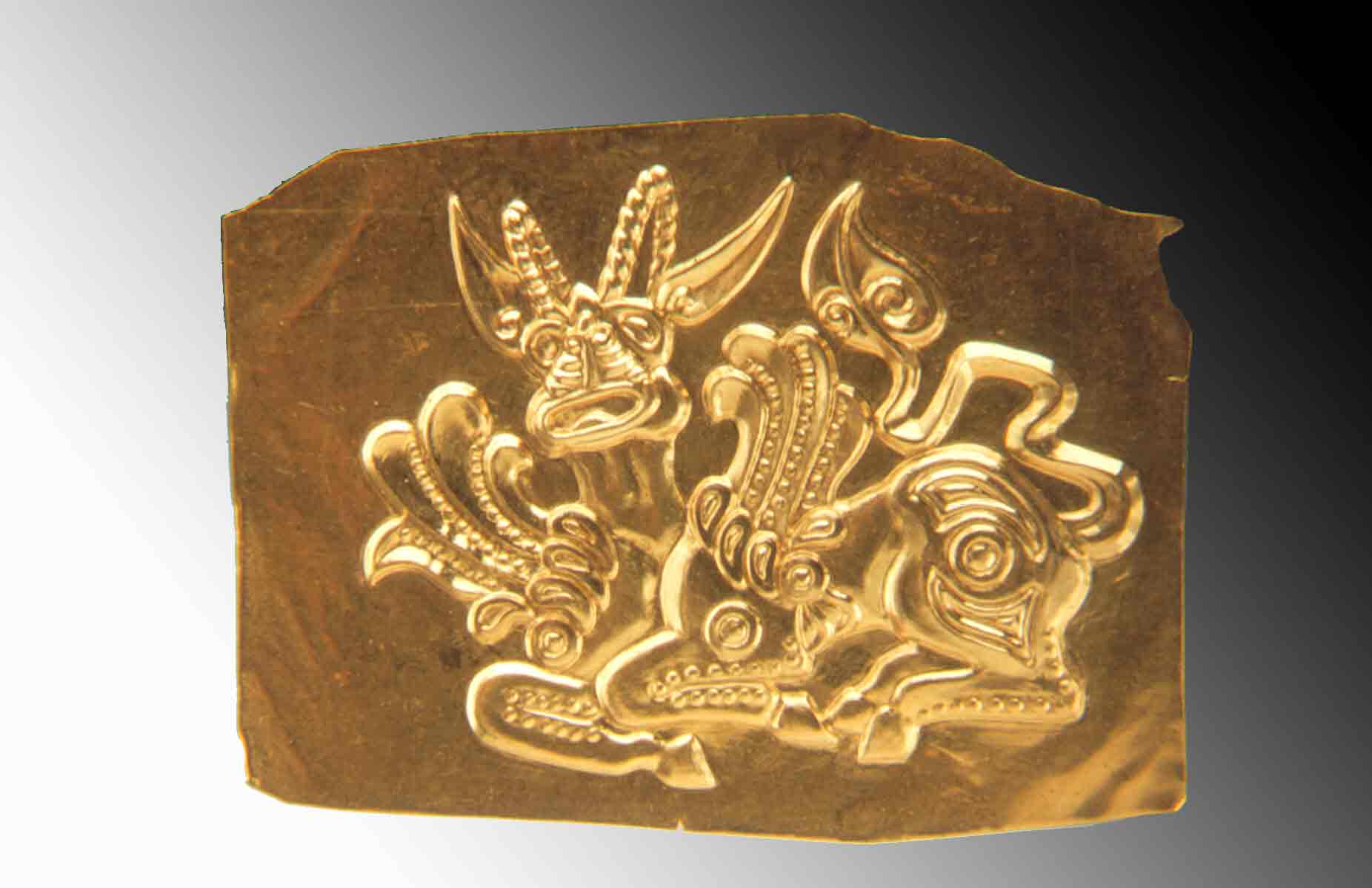 A portable art that revels in compression and bows to the universal human longing for the precious. An art that grows from deep patience, and a life constructed to allow for that growth. It does not demand the grand gesture, but the small, daily gestures--of nudging, coaxing, shaping, carving--that yield, in the end, a grand object requiring no pilgrimage because it is defined by proximity to the body. Like a ring, a brooch--or a garden. Just as the illusionist secrets of the classical world survived in the margins of illuminated books, perhaps the deeper secrets of a human-scaled art have survived to this day in jewelry and small sculpture. The 20th century prized the monumental and marginalized the intimate; it began with a declaration of the new that became a repudiation of the past. Now, at the start of the 21st, the past is once again revealing itself as a nourishing ground for invention, not simply a source of clever quotations. In a world that prizes the cerebral and bodiless transmission of knowledge, we seem starved for the sensual feel of surfaces and textures. Painters are turning to renaissance techniques, photographers are experimenting with old processes like gum bichromate, and sculptors are reviving the "lost" methods of the ancients. Silverman's art is part of this quiet revolution, but he has been working in this manner for over three decades now, pursuing his own passion. Traveling the globe and studying the visual legacy of so many cultures, he has become a master synthesizer and innovator, inspired by the ancient Egyptians, Persians, Scythians, Greeks, Romans, Chinese and others who also shaped the beautiful materials of this earth into works that we still admire today. When we visit museum galleries devoted to ancient art we are struck by levels of craftsmanship that seem far beyond the abilities of our advanced era: the miniature faience baboons and ibis of ancient Egypt, the granulated gold earrings worn by a Greek woman thousands of years ago. We wonder at the spiritual and material resources that enabled these traditions and their anonymous masters to flourish. But the work of Sumner Silverman reminds us that these are still living traditions, and in the hands of a contemporary master, they are being sustained and enriched.
A portable art that revels in compression and bows to the universal human longing for the precious. An art that grows from deep patience, and a life constructed to allow for that growth. It does not demand the grand gesture, but the small, daily gestures--of nudging, coaxing, shaping, carving--that yield, in the end, a grand object requiring no pilgrimage because it is defined by proximity to the body. Like a ring, a brooch--or a garden. Just as the illusionist secrets of the classical world survived in the margins of illuminated books, perhaps the deeper secrets of a human-scaled art have survived to this day in jewelry and small sculpture. The 20th century prized the monumental and marginalized the intimate; it began with a declaration of the new that became a repudiation of the past. Now, at the start of the 21st, the past is once again revealing itself as a nourishing ground for invention, not simply a source of clever quotations. In a world that prizes the cerebral and bodiless transmission of knowledge, we seem starved for the sensual feel of surfaces and textures. Painters are turning to renaissance techniques, photographers are experimenting with old processes like gum bichromate, and sculptors are reviving the "lost" methods of the ancients. Silverman's art is part of this quiet revolution, but he has been working in this manner for over three decades now, pursuing his own passion. Traveling the globe and studying the visual legacy of so many cultures, he has become a master synthesizer and innovator, inspired by the ancient Egyptians, Persians, Scythians, Greeks, Romans, Chinese and others who also shaped the beautiful materials of this earth into works that we still admire today. When we visit museum galleries devoted to ancient art we are struck by levels of craftsmanship that seem far beyond the abilities of our advanced era: the miniature faience baboons and ibis of ancient Egypt, the granulated gold earrings worn by a Greek woman thousands of years ago. We wonder at the spiritual and material resources that enabled these traditions and their anonymous masters to flourish. But the work of Sumner Silverman reminds us that these are still living traditions, and in the hands of a contemporary master, they are being sustained and enriched.
K.E. Duffin
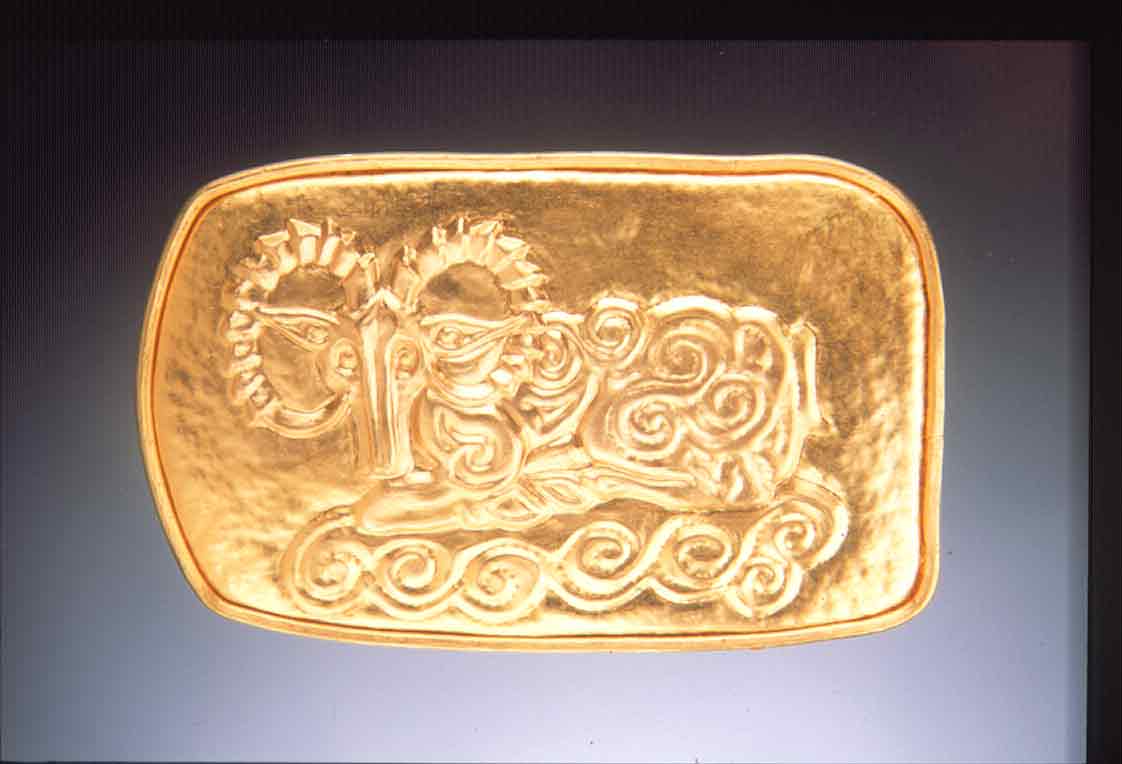

| Back to Home |